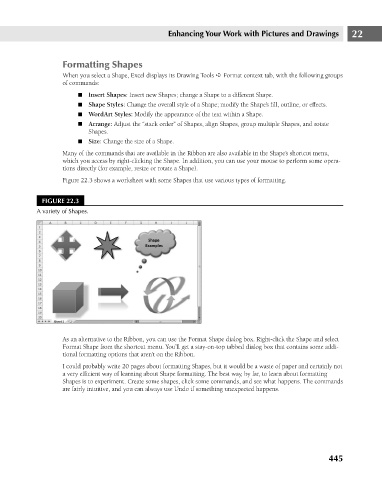Page 488 - Excel 2007 Bible
P. 488
28_044039 ch22.qxp 11/21/06 11:12 AM Page 445
Enhancing Your Work with Pictures and Drawings
Formatting Shapes
When you select a Shape, Excel displays its Drawing Tools ➪ Format context tab, with the following groups
of commands:
n Shape Styles: Change the overall style of a Shape; modify the Shape’s fill, outline, or effects.
n WordArt Styles: Modify the appearance of the text within a Shape.
n Arrange: Adjust the “stack order” of Shapes, align Shapes, group multiple Shapes, and rotate
Shapes.
n Size: Change the size of a Shape.
Many of the commands that are available in the Ribbon are also available in the Shape’s shortcut menu,
which you access by right-clicking the Shape. In addition, you can use your mouse to perform some opera-
tions directly (for example, resize or rotate a Shape).
Figure 22.3 shows a worksheet with some Shapes that use various types of formatting.
FIGURE 22.3 n Insert Shapes: Insert new Shapes; change a Shape to a different Shape. 22
A variety of Shapes.
As an alternative to the Ribbon, you can use the Format Shape dialog box. Right-click the Shape and select
Format Shape from the shortcut menu. You’ll get a stay-on-top tabbed dialog box that contains some addi-
tional formatting options that aren’t on the Ribbon.
I could probably write 20 pages about formatting Shapes, but it would be a waste of paper and certainly not
a very efficient way of learning about Shape formatting. The best way, by far, to learn about formatting
Shapes is to experiment. Create some shapes, click some commands, and see what happens. The commands
are fairly intuitive, and you can always use Undo if something unexpected happens.
445

